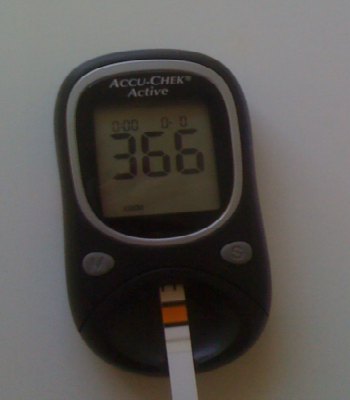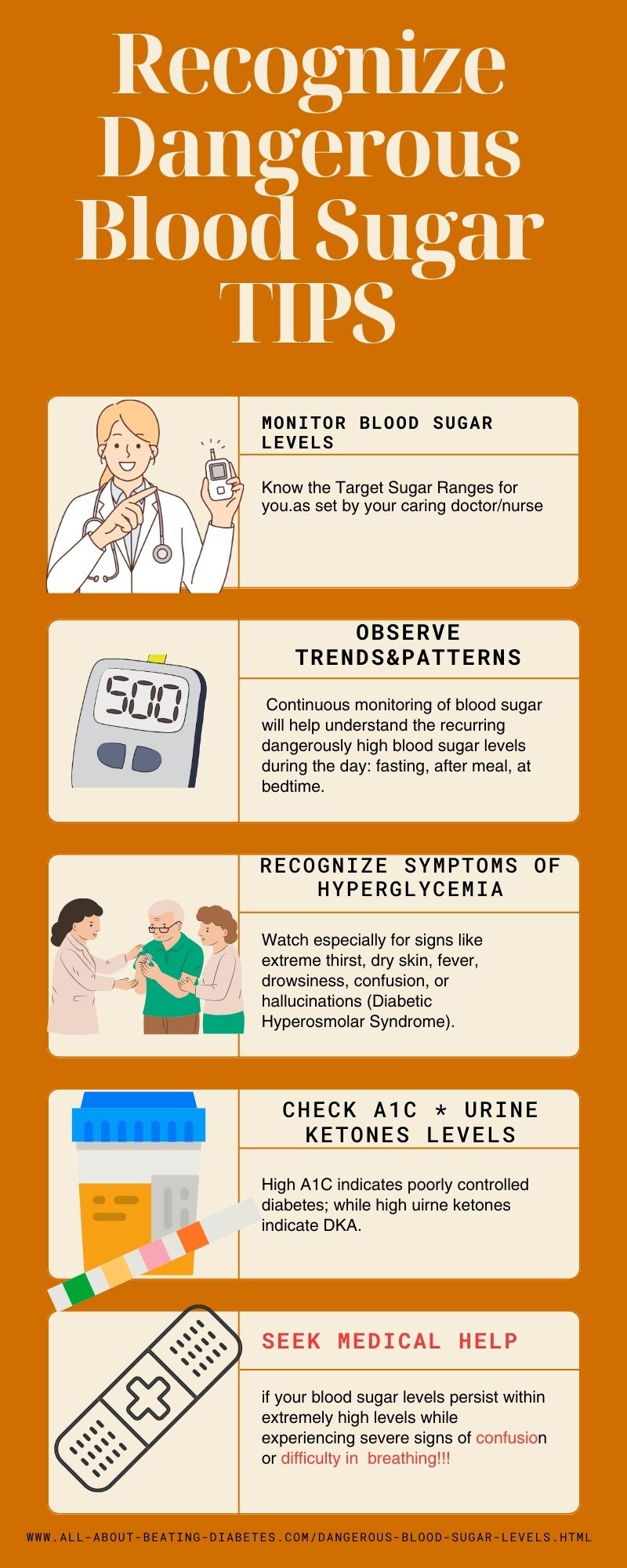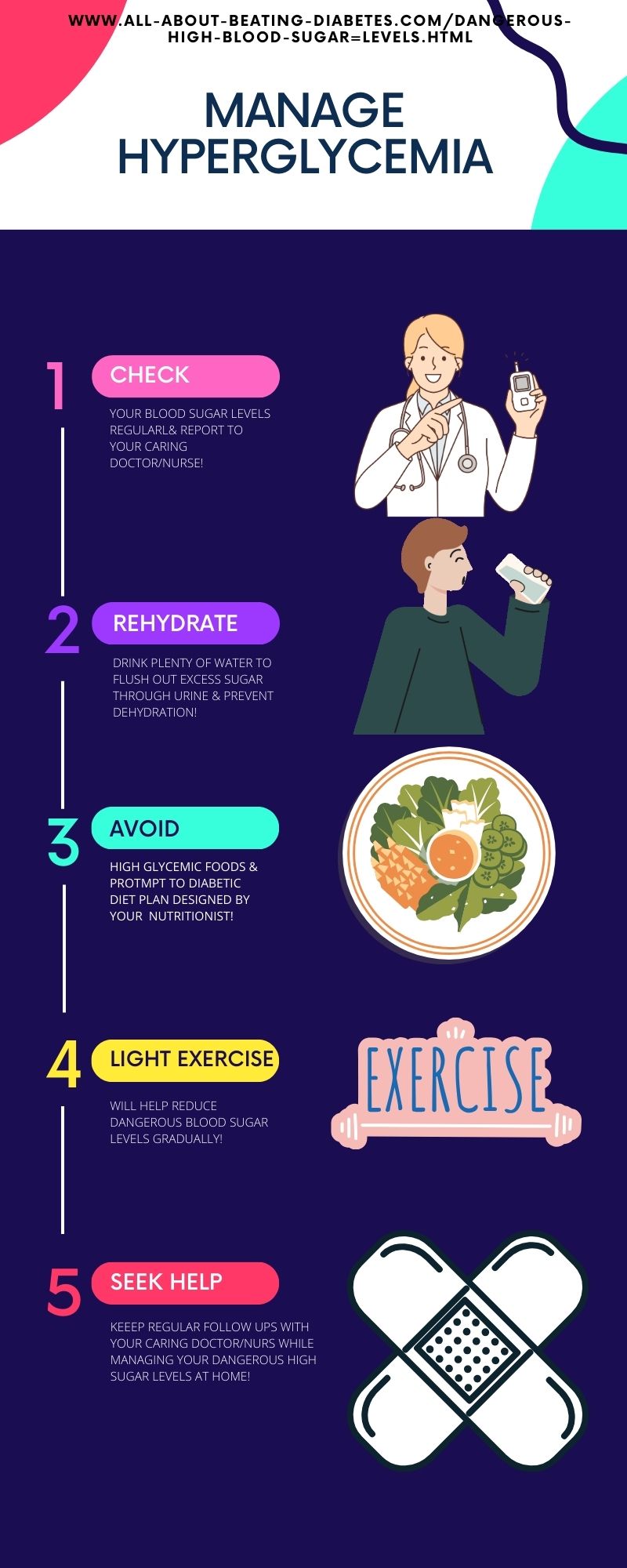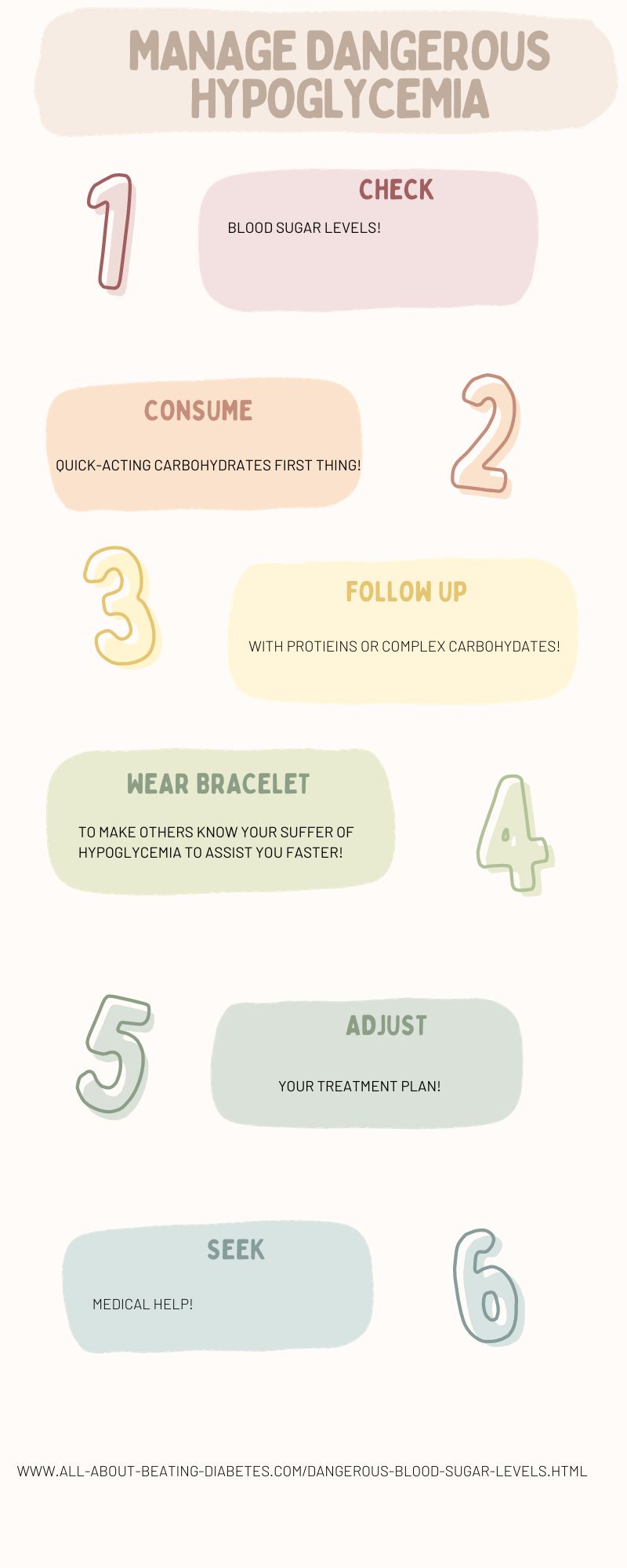- Home
- blood sugar levels
- Dangerous levels
Dangerous Blood Sugar Levels
Dangerous blood sugar levels pose significant challenges for both the mental well-being and overall health of individuals with diabetes.
Don't fret. Take a moment to unwind.
Keep in mind: stress is an adversary in your battle against diabetes. How so?
Under stress, your body generates hormones that escalate blood sugar levels, simultaneously impeding insulin function.
As a result, your blood sugar levels may rise significantly, aiding you in coping with your "stressful situation."
However, these levels can escalate to their peak, becoming unmanageable and classified as dangerously high blood glucose levels.
What are the dangerously high blood sugar levels for diabetics?
Dangerous blood sugar levels for individuals with diabetes can vary based on factors such as the type of diabetes, age, overall health, and specific circumstances.
Normally, blood sugar levels will always stay at high levels in diabetics.
1. Fasting Blood Sugar (before meals): Consistently above 250-300 mg/dL or higher is considered dangerously high for individuals with diabetes.
2. Postprandial Blood Sugar (after meals): Consistently above 300 mg/dL two hours after eating is often viewed as dangerously high and requires immediate attention.
How to recognize and distinguish these dangerously high levels?
Recognizing dangerously high blood sugar levels (hyperglycemia) is essential for individuals with diabetes to take prompt action and manage their condition effectively.
Following are some ways to identify when your blood sugar levels are dangerously high:
1. Monitor Blood Sugar Levels: Regularly check your blood sugar levels using a glucometer as recommended by your healthcare provider.
This will provide you with real-time information about your blood sugar levels.
2. Know Your Target Ranges: Understand the target blood sugar ranges set by your healthcare provider for fasting, pre-meal, post-meal, and bedtime.
Deviations from these targets could indicate dangerously high levels.
3. Recognize Symptoms of Hyperglycemia: Be vigilant for signs of high blood sugar, including excessive thirst, frequent urination, fatigue, blurry vision, dry mouth, persistent headaches, unexplained weight loss, and slow healing of wounds.
4. Check for High Ketones: If you have type 1 diabetes, monitor for ketones in your urine using ketone test strips, especially when your blood sugar levels are consistently high.
High ketone levels can be a sign of diabetic ketoacidosis (DKA), a severe condition requiring immediate medical attention.
5. Observe Trends and Patterns: Pay attention to recurring high blood sugar levels at specific times of the day or after certain meals.
Identifying patterns can help you make necessary adjustments to your diabetes management plan.
6. Consider Continuous Glucose Monitoring (CGM): If recommended by your healthcare provider, use a CGM system to continuously monitor your blood sugar levels.
CGMs can provide real-time data and alerts for high blood sugar levels.
7. Check for Symptoms of Diabetic Hyperosmolar Syndrome (HHS): Watch for signs like extreme thirst, dry skin, fever, drowsiness, confusion, or hallucinations, which can indicate HHS—a serious condition often caused by very high blood sugar levels.
8. Regularly Review Hemoglobin A1c (HbA1c) Levels: Periodically assess your HbA1c levels as per your healthcare provider's recommendations.
Elevated HbA1c levels may indicate a pattern of poorly controlled blood sugar levels over time.
9. Seek Immediate Medical Attention: If you experience severe symptoms like confusion, difficulty breathing, or loss of consciousness, seek emergency medical care.
Extremely high blood sugar levels can be life-threatening and require immediate intervention.
By staying vigilant, monitoring your blood sugar levels regularly, recognizing symptoms, and following your healthcare provider's advice, you can effectively identify dangerously high blood sugar levels and take appropriate action to manage your diabetes.
Always prioritize your health and safety in managing your condition.
What too low blood sugar is considered dangerous?
Amongst diabetics, there is another concern regarding their blood sugar readings: VERY LOW BLOOD SUGAR LEVELS.
In general, dangerously low blood sugar levels, also known as hypoglycemia, are typically defined as blood sugar levels below 70 milligrams per deciliter (mg/dL).
However, for individuals with diabetes, what is considered "dangerously low" can vary based on individual circumstances, overall health, age, and individualized diabetes management plans.
For those with diabetes, severe hypoglycemia is often characterized by a blood sugar level below 54 mg/dL.
At this level, the brain may not receive enough glucose, leading to significant symptoms and impairments, such as confusion, seizures, loss of consciousness, and in severe cases, coma or death.
It's important to note that each person may have different thresholds at which they experience symptoms of hypoglycemia, even at levels above 70 mg/dL.
Some individuals may experience symptoms at higher blood sugar levels, and it's essential to be aware of your own unique symptoms and response to low blood sugar.
What should I do if my blood sugar levels are dangerously high or low?
Managing blood sugar levels that are dangerously high or low is critical for individuals with diabetes.
Here are steps to take if you experience either dangerously high (hyperglycemia) or low (hypoglycemia) blood sugar levels:
If Blood Sugar Levels are Dangerously High (Hyperglycemia):
1. Check Blood Sugar Levels: Use a glucometer to confirm high blood sugar levels.
2. Rehydrate: Drink plenty of water to help flush out excess sugar through urine and prevent dehydration.
3. Contact Healthcare Provider: Call your healthcare provider to inform them of the high blood sugar levels and seek guidance on how to manage the situation effectively.
4. Administer Insulin (if prescribed): Administer the prescribed insulin as per your healthcare provider's instructions.
5. Engage in Physical Activity: Engage in light physical activity to help lower blood sugar levels.
6. Follow a Healthy Eating Plan: Consume a healthy, balanced meal or snack as recommended by your healthcare provider to help stabilize your blood sugar levels.
7. Avoid High-Glycemic Foods: Avoid foods and drinks that can cause a rapid spike in blood sugar, such as sugary beverages, sweets, and processed carbohydrates.
8. Monitor Blood Sugar Regularly: Check your blood sugar levels frequently to track your progress and ensure they are gradually coming down.
9. Seek Medical Attention (if necessary): If your blood sugar levels remain dangerously high or if you experience severe symptoms, seek immediate medical attention.
If Blood Sugar Levels are Dangerously Low (Hypoglycemia):
1. Check Blood Sugar Levels: Use a glucometer to confirm low blood sugar levels.
2. Consume Quick-Acting Carbohydrates: Consume a source of quick-acting carbohydrates, such as glucose tablets, fruit juice, candy, or honey, to raise your blood sugar.
3. Follow Up with Protein or Complex Carbohydrates: Once your blood sugar stabilizes, consume a snack or meal containing protein or complex carbohydrates to prevent another drop in blood sugar.
4. Communicate with Healthcare Provider: Inform your healthcare provider about the hypoglycemic episode and discuss potential adjustments to your diabetes management plan.
5. Wear a Medical Alert Bracelet: Consider wearing a medical alert bracelet or necklace indicating you have diabetes to alert others in case of severe hypoglycemia.
6. Adjust Your Treatment Plan: Work with your healthcare provider to make appropriate adjustments to your insulin, medications, meal plan, or physical activity to minimize the risk of future hypoglycemic episodes.
7. Seek Medical Attention (if necessary): If you experience severe symptoms or are unable to consume carbohydrates, seek immediate medical attention.
Always follow your healthcare provider's recommendations and have an emergency plan in place for managing both high and low blood sugar.
Regular communication with your healthcare team is essential for effective diabetes management and addressing episodes of dangerously high or low blood sugar.
What are the complications of consistently high blood sugar levels?
Consistently high blood sugar levels, or hyperglycemia, pose serious health risks and can lead to debilitating complications over time.
These complications primarily affect the cardiovascular system, kidneys, eyes, nerves, and other organs.
Prolonged hyperglycemia increases the risk of heart disease, including atherosclerosis, heart attacks, and strokes.
It also contributes to high blood pressure and peripheral artery disease, impacting blood flow to the limbs.
The kidneys are at risk of diabetic nephropathy, causing chronic kidney disease and eventual failure.
High blood sugar damages blood vessels in the eyes, potentially leading to diabetic retinopathy, cataracts, and glaucoma, risking vision loss.
Nerve damage, known as peripheral neuropathy, results in pain, numbness, and tingling in the extremities, affecting daily life and causing complications in digestion and sexual function.
Skin complications, like slow wound healing and infections, are also common.
Foot complications, such as diabetic foot ulcers, can lead to severe infections and, in extreme cases, amputation.
Hyperglycemia affects bone density, increasing the risk of osteoporosis, and disrupts gastrointestinal function, causing gastroparesis.
Immune system impairment and hormonal/metabolic imbalances are additional concerns.
Can dangerously high blood sugar levels be life-threatening?
Yes, dangerously high blood sugar levels, also known as hyperglycemia, can be life-threatening.
When blood sugar levels rise significantly and remain uncontrolled, it can lead to a condition called diabetic ketoacidosis (DKA) in individuals with diabetes, particularly type 1 diabetes.
DKA occurs when the body can't use glucose for energy due to a lack of insulin, causing the body to break down fat for fuel.
This process produces ketones, which can make the blood acidic and can result in a range of serious symptoms such as extreme thirst, frequent urination, nausea, vomiting, confusion, and even loss of consciousness.
Hyperosmolar hyperglycemic state (HHS) is another life-threatening complication seen more often in type 2 diabetes, typically in elderly individuals.
HHS occurs when blood sugar levels become extremely high, causing severe dehydration, neurological symptoms, and, if left untreated, can lead to seizures, coma, and even death.
Prompt medical attention, appropriate hydration, insulin therapy, and close monitoring are critical in managing dangerously high blood sugar levels and preventing these life-threatening complications.
Can dangerously low blood sugar levels be life-threatening?
Yes, dangerously low blood sugar levels, also known as severe hypoglycemia, can be life-threatening, especially for individuals with diabetes.
Hypoglycemia deprives the brain and other organs of glucose, their primary source of energy, leading to a range of serious and potentially fatal symptoms.
In severe cases, hypoglycemia can cause loss of consciousness, seizures, and convulsions, which can lead to traumatic injuries or accidents.
Moreover, if a person is unconscious due to hypoglycemia, they may not be able to treat themselves or seek help, making it critical for others to intervene promptly.
If left untreated, severe hypoglycemia can progress to a coma and, in extreme cases, result in irreversible brain damage or death.
What are the immediate steps to take if my blood sugar levels are dangerously high?
If you suspect your blood sugar levels are dangerously high, it's crucial to take immediate action to bring them under control and seek medical help.
Follow these steps:
1. Check Blood Sugar: Confirm your high blood sugar with a glucose monitor. If the reading is significantly elevated, proceed with the following steps.
2. Stay Hydrated: Drink plenty of water to help flush excess sugar from your bloodstream and prevent dehydration, a common complication of high blood sugar.
3. Contact Healthcare Professional: Call your healthcare provider or go to the nearest hospital emergency room to seek guidance and inform them of your high blood sugar levels.
4. Administer Insulin (if prescribed): If you're on insulin therapy, follow your healthcare provider's instructions for administering additional insulin to lower your blood sugar levels.
Do not exceed the prescribed dose.
5. Monitor Ketones: If you're a person with type 1 diabetes or your healthcare provider advises, check for ketones in your urine or blood.
High ketone levels may indicate diabetic ketoacidosis (DKA), requiring immediate medical attention.
6. Follow Medical Advice: Adhere to any specific instructions given by your healthcare provider, and go to the hospital if advised or if symptoms worsen.
7. Avoid High-Carb Foods: Refrain from consuming high-carbohydrate foods or sugary items that can further spike your blood sugar levels.
How can I quickly raise my blood sugar if it's dangerously low?
If you are experiencing dangerously low blood sugar levels (severe hypoglycemia), it's crucial to act quickly to raise your blood sugar levels to a safe range.
Here are steps to do so:
1. Consume Fast-Acting Carbohydrates: Eat or drink a fast-acting source of glucose, such as glucose tablets, a glucose gel, fruit juice, regular soda, or a sugary candy (e.g., hard candy, jelly beans).
Aim for approximately 15 grams of carbohydrates.
2. Recheck Blood Sugar: Wait for about 15 minutes, then check your blood sugar again to ensure it has risen to a safe level.
If it's still low, repeat the previous step.
3. Follow up with Sustained Carbohydrates: Once your blood sugar stabilizes, consume a more sustained source of carbohydrates, such as a piece of fruit, crackers with peanut butter, or a small snack.
4 Glucagon Injection (if prescribed): If you have a prescribed glucagon emergency kit, someone trained in administering it can give you a glucagon injection to raise blood sugar levels.
5. Seek Medical Attention: If you're unable to raise your blood sugar, if symptoms persist or worsen, or if you're unable to consume food or fluids, seek immediate medical help or call emergency services.
How do I prevent dangerously high blood sugar levels?
Preventing dangerously high blood sugar levels involves consistent management of your diabetes and a healthy lifestyle.
Here are important steps to help keep your blood sugar levels in a safe range:
1. Regular Monitoring: Check your blood sugar levels as recommended by your healthcare provider to track and understand your patterns.
2. Healthy Diet: Adopt a balanced diet rich in whole grains, lean proteins, healthy fats, and plenty of fruits and vegetables.
Monitor carbohydrate intake and be mindful of portion sizes.
3. Regular Exercise: Engage in regular physical activity as advised by your healthcare provider to improve insulin sensitivity and regulate blood sugar levels.
4. Medication Adherence: Take prescribed medications as directed by your healthcare provider, including insulin, if applicable.
Follow the recommended dosages and timings.
5. Stress Management: Employ stress-reduction techniques such as meditation, deep breathing, yoga, or hobbies to manage stress, as it can affect blood sugar levels.
6. Adequate Sleep: Ensure you get sufficient and quality sleep to support overall health and maintain stable blood sugar levels.
7. Hydration: Stay well-hydrated by drinking enough water throughout the day to help regulate blood sugar levels and prevent dehydration.
8. Regular Medical Check-ups: Attend regular check-ups with your healthcare provider for comprehensive diabetes management and adjustment of your treatment plan, if needed.
9. Education and Support: Educate yourself about diabetes, its management, and seek support from healthcare professionals, diabetes educators, or support groups to enhance your knowledge and coping strategies.
What are the short-term and long-term dangers of consistently low blood sugar levels?
Consistently low blood sugar levels, known as hypoglycemia, present immediate and potential long-term dangers for individuals with diabetes.
Short-term dangers include:
1. Cognitive Impairment: Hypoglycemia can cause confusion, difficulty concentrating, dizziness, and in severe cases, loss of consciousness.
This affects decision-making and can lead to accidents or injuries.
2. Physical Weakness and Fatigue: Low blood sugar levels can result in weakness, fatigue, shakiness, and irritability, affecting daily activities and productivity.
3. Blurred Vision and Difficulty Speaking: Vision problems and speech difficulties can occur during episodes of hypoglycemia, impairing communication and potentially leading to accidents.
4. Seizures or Convulsions: Severe hypoglycemia can lead to seizures, which are dangerous and require immediate medical attention.
5. Loss of Consciousness: If left untreated or if not treated promptly, hypoglycemia can cause loss of consciousness or fainting, posing significant risks to the individual's safety and well-being.
Long-term dangers may include:
a. Impaired Awareness of Hypoglycemia (IAH): Repeated episodes of hypoglycemia can lead to impaired awareness, where individuals no longer experience the warning signs or symptoms of low blood sugar.
This increases the risk of severe hypoglycemia and its associated dangers.
b. Counterregulatory Hormone Dysfunction: Frequent episodes of hypoglycemia can disrupt the body's natural response to low blood sugar, making it harder to recover and increasing the risk of subsequent episodes.
c. Brain Function and Cognitive Decline: Chronic hypoglycemia may lead to subtle cognitive impairments and, over time, potentially contribute to accelerated cognitive decline.
Take-Home Tips
- The most important thing is to prevent these events through accurate checking of your blood sugar, do not overload with exercise or avoiding alcohol.
- If your drugs will cause hypoglycemic episodes, then, you should ask your doctor to adjust their dose according to your body needs.
- You can ask our doctors and get the answers. Just click here.
|
Written by Dr.Albana Greca Sejdini, Md, MMedSc Medically reviewed by Dr.Ruden Cakoni, MD, Endocrinologist |
Last reviewed 10/06/2023 |
References:
Diabetes complications Questions or Problems? Get Help Here
This is the place where you can ask a question about any aspect of diabetes complications.
It's free and it's easy to do. Just fill in the form below, then click on "Submit Your Question".







